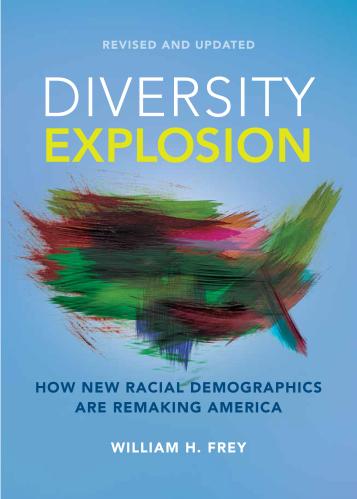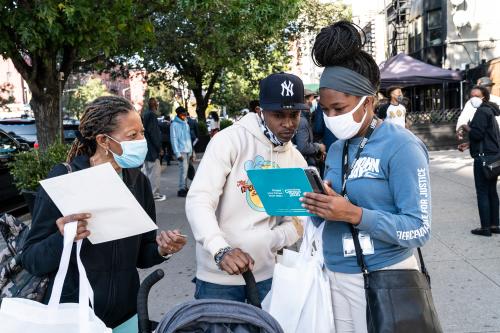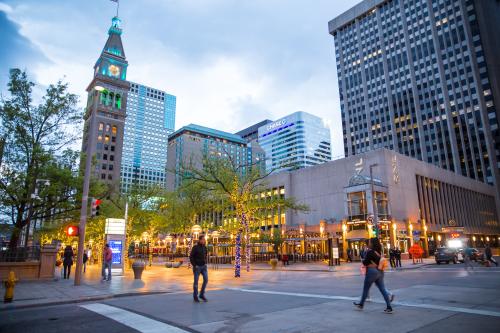This report is part of a series by the author on the results of the 2020 census.
Contents
- The past decade saw slower growth and white population loss
- More than two-fifths of Americans now identify as people of color
- Population gains and losses varied across states and regions
- The youth population declined in 27 states and the nation as a whole
- People of color comprise over half of the nation’s youth
- Chronicling the diversity of today and tomorrow
The first release of race-ethnic statistics from the 2020 census makes plain that America’s “diversity explosion” is continuing, albeit in the context of slower national growth, especially among the youth. The new numbers show that, for the first time, there was a decade-long loss in the number of white Americans who do not identify with other racial and ethnic groups. This means that all of the nation’s 2010-to-2020 growth is attributable to people of color—those identifying as Latino or Hispanic, Black, Asian American, Native Hawaiian or Pacific Islander, Native American, and as two or more races.1 Together, these groups now comprise more than 40% of the U.S. population.
While previously released 2020 census results indicated a marked slowdown in national population growth, the new release shows that both slow growth and increased diversity are particularly evident among the young. Between 2010 and 2020, the nation’s under-age-18 population registered an absolute decline of more than 1 million. This resulted from a notable loss in the white youth population that was not fully countered by gains in other racial and ethnic groups. As a result, white Americans now comprise less than half of the nation’s under-age-18 population.
These statistics, released as part of the Census Bureau’s redistricting file, reveal variations in such patterns across states. Thus, they emphasize the importance of different racial and ethnic group populations in accounting for each area’s growth or decline. Particularly noteworthy is the dominance of Latino or Hispanic contributions to growth in places that otherwise might have lost population during the 2010s.
The past decade saw slower growth and white population loss
The nation’s 2010-to-2020 growth rate of 7.4% was lower than any decade since the 1930s. So it is not surprising that the growth rates of some racial and ethnic groups also declined compared to the previous decade. This is especially the case for Latino or Hispanic Americans, at 23%—down from 43% in 2000 to 2010 (download Table A). This has much to do with the decade’s downturns in fertility and immigration; the former due to the economic slowdown in the aftermath of the Great Recession and the latter due both to a sagging economy in the early 2010s and restrictive immigration in the later part of the decade.

Yet most notable is the small decline in white population—the first in any census since 1790. During much of the nation’s history, white population growth mirrored the national growth rate, including a substantial slowdown during the Great Depression. Yet, since the 1970s, white population growth has shown continued declines—plummeting to just 1.2% in 2000 to 2010 and now to a -2.6% loss (or over 5 million people) for the 2010s.
In addition to lower fertility and immigration, much of this loss is attributable to the continued aging of the white population. Fewer births and more deaths resulted in a natural decrease (more deaths than births) for the 2010s decade, even before the COVID-19 pandemic. In addition, the rise of multiracial marriages has led to an increase in the number of young people who identify as mixed race rather than white alone. The new census results also show a substantial rise in the number of Americans that indicated belonging to two or more racial groups.
These shifts have led to a situation in which other nonwhite race and ethnic groups accounted for all of the 2010-to-2020 gains in the U.S. population. The biggest contributions came from Latino or Hispanic Americans, at 11.6 million—representing roughly half of the nation’s total decade gain of 22.7 million. Asian Americans and persons identifying as two or more races were also a large contributors to the total decade population gain.

Although 35 states registered white population losses over the decade, only three of those (Illinois, Mississippi, and West Virginia) showed total population declines. In the remaining states (including California, New York, New Jersey, and Massachusetts), nonwhite race and ethnic groups drove all of the 2010s growth. A good example is California, which led the nation in white population losses (1.2 million), but benefitted from large Latino or Hispanic gains (1.5 million) and Asian American gains (1.2 million). Moreover in all of the states that gained white population over the decade, their combined nonwhite populations contributed to over half of their growth. (Washington, D.C., where white population growth dominated, differs from these.) Among all states plus Washington, D.C., Latino or Hispanic Americans contributed to half or more of 2010-to-2020 gains in 22 of them (download Table B).
White population declines were pervasive across large parts of the nation, including 61 of the 100 largest metropolitan areas; 196 of the 319 cities over 100,000 population; and 2,458 of the nation’s 3,100-plus counties. Yet fewer of these areas experienced overall population losses (three large metro areas, 37 large cities, and 1,650 counties) because their white losses were more than countered by gains from other racial and ethnic groups
More than two-fifths of Americans now identify as people of color
One diversity milestone that was achieved with the 2020 census numbers is that a substantial plurality (more than 40%) of Americans now identify as one or more racial and ethnic groups.

The past several censuses have shown increased racial and ethnic diversity among the U.S. population. In 1980, white residents comprised almost 80% of the national population, with Black residents accounting for 11.5%, and Latino or Hispanic residents at 6.4%. By 2000, the Latino or Hispanic population showed a slightly higher share than the Black population: 12.5% versus 12.1%. By then, the Asian American population share had grown to 3.6%, while the white population share dropped to 69.1%
Now, 20 years later, the white population share has declined to 57.8%. The Latino or Hispanic and Asian American population shares have risen to 18.7% and nearly 6%, respectively. While these groups fluctuated over the past 40 years, either upward (for Latino or Hispanic and Asian American populations) or downward (for the white population), the Black share of the population remained relatively constant.
The new census data shows declining white population shares are pervasive across the nation. Over the 2010-to-2020 decade, the white population share declined in all 50 states (though not Washington, D.C.) with marked declines in several. In Nevada, the white population share dropped from 65% in 2000 to 54% in 2010, then to 46% in 2020 (download Table C). White population shares declined in 381 of the nation’s 384 metropolitan areas and 2,982 of its 3,140 counties.
Moreover, the 2020 census shows that six states and Washington, D.C. are minority-white, with both Maryland and Nevada achieving that status since 2010. Also, 27 of the 100 largest metropolitan areas have minority-white populations, including Dallas; Orlando, Fla.; Atlanta; Austin, Texas; New Orleans; and Sacramento, Calif., which reached this status in 2020.
Population gains and losses varied across states and regions
Despite the slow national growth in the 2010s decade, there was wide variation in gains across states for different racial and ethnic groups. As discussed above, 35 states lost white population over this period. Yet, most states gained Latino or Hispanic, Black, and Asian American residents (download Table D).

There are distinctions among the top population-gaining states for each ethnic group. States that saw gains in white residents are almost exclusively located in the Sun Belt, led by Utah, Colorado, and Florida. In fact, the 11 states (including Washington, D.C.) with the greatest numeric white gains are all located in the South and West regions. In contrast, seven of the eight states with greatest white population losses are in the Northeast and Midwest, including the highly urbanized states of New York, Illinois, and New Jersey. The one Sun Belt exception is California, another urbanized state, which led all others in white population losses.
Black population gains also favor the Sun Belt, led by Texas, Georgia, and Florida. This is consistent with the recent history of Black migration patterns toward prosperous southern states, countering the “great migration” of African Americans out of the South in the first half of the 20th century. Yet several non-Southern states—including Minnesota, Nevada, and Arizona—have also attracted Black Americans during the past decade. At the other end of the spectrum are seven states and Washington, D.C. which registered losses in Black residents. The largest losses occurred in Illinois, California, Michigan, and New York. These are among the states that now serve as origins for the “reverse migration” back to the South.
States that gained the most Latino or Hispanic and Asian American residents differ somewhat from the two previous groups. These tend to be that states historically attracted immigrant members of these populations, including Texas, California, Florida, and New York. Although both groups’ populations are dispersing across the country, overall gains are still heavily clustered in these states.
The youth population declined in 27 states and the nation as a whole
The new 2020 census data allows assessment of the size and recent changes in the nation’s under-age-18 population (referred to here as the “youth” population). An especially noteworthy finding is the overall decline in this population over the 2010-to-2020 decade. In a country that is rapidly aging, an absolute decline in the youth population represents a demographic challenge for the future.


The 2010-to-2020 loss of over 1 million youths contrasts with gains in that population during the previous two decades. While this is not the first decade to register a loss in the nation’s youth, it is occurring at a time of greater aging of the population. This differs from the situation in the 1960s, when much of the large baby boomer population was under age 18, and comprised 35% of the total population. This youth share dipped over time and has now reached 22%.
What this means is that youths comprise a demographically smaller share of the population while the overall population is aging. As the large baby boomer population advances beyond their primary labor force ages, both youths and the labor-force-age population will only grow modestly at best.
The national picture of the youth population loss is evident and even exaggerated in large parts of the country. Between 2010 and 2020, 27 states registered absolute declines in their youth populations. These states are located in all regions of the country, but especially in the Northeast (download Table E).
…
Map 1: Growth and declines in state under age 18 populations, 2010-2020
…
Source: William H. Frey analysis of 2010 and 2020 U.S. decannial censuses.
Note: Percent 2010-2020 growth of persons under age 18
People of color comprise over half of the nation’s youth
The growth stagnation of the nation’s youth population would be even more severe were it not for the contributions of people of color. Because immigrants and their U.S.-born children, together, are younger than the rest of the population, recent decades’ immigration from Latin America, Asia, and elsewhere served to bolster the size of the nation’s youth population. This is evident in the contributions of different race-ethnic groups over the 2010-to-2020 period, which shows that Latino or Hispanic youth, Asian American youth, and youth identifying with two are more races contributed to almost all of this age group’s population gains.

Were it not for these race-ethnic groups, the last decade’s decline in the youth population would have been substantial. The white youth population has been declining since 2000 due to the more advanced aging of white Americans and a proportionately smaller share of white women in their child-bearing years. And this population is projected to further decline for decades to come. Similarly, there were more modest declines in the number of Black youths as well as those who identify as American Indians and Alaska Natives.
This dynamic occurred in most states. All states except Utah and North Dakota (and the Washington, D.C.) showed 2010-to-2020 declines in their white youth populations (download Table F). However, in 21 of those—including Texas and Florida, the states with the largest numeric youth gains—white youth losses were more than countered by gains in youths of color. Because the vast majority of states also show losses in their Black and American Indian and Alaska Native youth populations, youth gains tend to come largely from Latino or Hispanic youth, Asian American youth, or persons identifying as two or more races.

Map 2: Nonwhite shares of state under age 18 populations, 2020
…
Source: William H. Frey analysis of 2020 U.S. decennial census.
Because of these contributions, people of color now comprise more than half of the nation’s total youth population, with Latino or Hispanic youths comprising 25.7% and Black youths at 13.2%.
The racial diversity of the nation’s youth population is well established nationally and expanding across the country. The 2020 census shows that half of the youth population in 21 states and over two-fifths of the youth population in an additional eight are people of color. In several southern states ranging from Louisiana to Virginia, Black youths make up the largest nonwhite share. However, in a number of states in the West (California, Arizona, New Mexico, and Nevada ) and South (Texas and Florida), Latino or Hispanic youths are highly represented (download Table G).
The rise of youths of color is a key element of the changing demographics of America’s under-age-18 population. These groups have not only stemmed a sharp decline in the youth population but, as they age, will be driving most of the growth in the nation’s labor force.
Chronicling the diversity of today and tomorrow
The decennial census is the gold standard for providing definitive statistics about the nation’s population. The new 2020 census results make more clear than any survey to date that, while slow-growing and aging, the nation is becoming far more racially and ethnically diverse—especially among its young.
From a demographics perspective, America’s aging and modestly declining white population is being bolstered by an array of younger racial and ethnic groups, including individuals who identify with more than one race. These patterns play out in different ways across the nation’s states, metropolitan areas, and counties.
Later releases from the 2020 census will permit further examination of this and related phenomena. However, it is already clear from the data just released that most places that are attracting growing populations are, by definition, becoming more racially and ethnically diverse—and in the years ahead, much more of the country will experience increased diversity as today’s younger population ages and disperses to new areas.
-
Footnotes
- Except for Latinos or Hispanics, data for all racial groups pertain to non-Latino or -Hispanic members of those groups.
The Brookings Institution is committed to quality, independence, and impact.
We are supported by a diverse array of funders. In line with our values and policies, each Brookings publication represents the sole views of its author(s).







